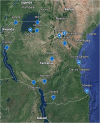Whole-genome sequencing of SARS-CoV-2 isolates from symptomatic and asymptomatic individuals in Tanzania
- PMID: 36687433
- PMCID: PMC9846855
- DOI: 10.3389/fmed.2022.1034682
Whole-genome sequencing of SARS-CoV-2 isolates from symptomatic and asymptomatic individuals in Tanzania
Abstract
Background: Coronavirus Disease-2019 (COVID-19), caused by Severe Acute Respiratory Syndrome Coronavirus 2 (SARS-CoV-2) accounts for considerable morbidity and mortality globally. Paucity of SARS-CoV-2 genetic data from Tanzania challenges in-country tracking of the pandemic. We sequenced SARS-CoV-2 isolated in the country to determine circulating strains, mutations and phylogenies and finally enrich international genetic databases especially with sequences from Africa.
Methods: This cross-sectional study utilized nasopharyngeal swabs of symptomatic and asymptomatic adults with positive polymerase chain reaction tests for COVID-19 from January to May 2021. Viral genomic libraries were prepared using ARTIC nCoV-2019 sequencing protocol version three. Whole-genome sequencing (WGS) was performed using Oxford Nanopore Technologies MinION device. In silico genomic data analysis was done on ARTIC pipeline version 1.2.1 using ARTIC nCoV-2019 bioinformatics protocol version 1.1.0.
Results: Twenty-nine (42%) out of 69 samples qualified for sequencing based on gel electrophoretic band intensity of multiplex PCR amplicons. Out of 29 isolates, 26 were variants of concern [Beta (n = 22); and Delta (n = 4)]. Other variants included Eta (n = 2) and B.1.530 (n = 1). We found combination of mutations (S: D80A, S: D215G, S: K417N, ORF3a: Q57H, E: P71L) in all Beta variants and absent in other lineages. The B.1.530 lineage carried mutations with very low cumulative global prevalence, these were nsp13:M233I, nsp14:S434G, ORF3a:A99S, S: T22I and S: N164H. The B.1.530 lineage clustered phylogenetically with isolates first reported in south-east Kenya, suggesting regional evolution of SARS-CoV-2.
Conclusion: We provide evidence of existence of Beta, Delta, Eta variants and a locally evolving lineage (B.1.530) from samples collected in early 2021 in Tanzania. This work provides a model for ongoing WGS surveillance that will be required to inform on emerging and circulating SARS-CoV-2 diversity in Tanzania and East Africa.
Keywords: COVID-19; MinION; Oxford Nanopore Technologies (ONT); SARS-CoV-2; variant of interest; variants of concern; whole-genome sequencing.
Copyright © 2023 Mziray, van Zwetselaar, Kayuki, Mbelele, Makubi, Magesa, Kisonga, Sonda, Kibiki, Githinji, Heysell, Chilongola and Mpagama.
Conflict of interest statement
CCK was employed by Oxford Nanopore Technologies. The remaining authors declare that the research was conducted in the absence of any commercial or financial relationships that could be construed as a potential conflict of interest.
Figures


Similar articles
-
A high scale SARS-CoV-2 profiling by its whole-genome sequencing using Oxford Nanopore Technology in Kazakhstan.Front Genet. 2022 Sep 2;13:906318. doi: 10.3389/fgene.2022.906318. eCollection 2022. Front Genet. 2022. PMID: 36118859 Free PMC article.
-
Detection of SARS-CoV-2 Variants Imported Through Land Borders at the Height of the COVID-19 Pandemic in Ghana, 2022.Cureus. 2024 Aug 30;16(8):e68220. doi: 10.7759/cureus.68220. eCollection 2024 Aug. Cureus. 2024. PMID: 39347199 Free PMC article.
-
SARS-CoV-2 Whole-Genome Sequencing Using Oxford Nanopore Technology for Variant Monitoring in Wastewaters.Front Microbiol. 2022 Jun 9;13:889811. doi: 10.3389/fmicb.2022.889811. eCollection 2022. Front Microbiol. 2022. PMID: 35756003 Free PMC article.
-
Molecular biology of SARS-CoV-2 and techniques of diagnosis and surveillance.Adv Clin Chem. 2024;118:35-85. doi: 10.1016/bs.acc.2023.11.003. Epub 2023 Dec 14. Adv Clin Chem. 2024. PMID: 38280807 Review.
-
SARS-CoV-2 Variants Identification: Overview of Molecular Existing Methods.Pathogens. 2022 Sep 17;11(9):1058. doi: 10.3390/pathogens11091058. Pathogens. 2022. PMID: 36145490 Free PMC article. Review.
Cited by
-
Genomic Surveillance and Molecular Characterization of SARS-CoV-2 Variants During the Peak of the Pandemic in Türkiye.Biochem Genet. 2024 Nov 8. doi: 10.1007/s10528-024-10962-8. Online ahead of print. Biochem Genet. 2024. PMID: 39516327
-
COVID-19 in 16 West African Countries: An Assessment of the Epidemiology and Genetic Diversity of SARS-CoV-2 after Four Epidemic Waves.Am J Trop Med Hyg. 2023 Aug 28;109(4):861-873. doi: 10.4269/ajtmh.22-0469. Print 2023 Oct 4. Am J Trop Med Hyg. 2023. PMID: 37640294 Free PMC article. Review.
-
Regional Evaluation of Two SARS-CoV-2 Antigen Rapid Diagnostic Tests in East Africa.Microbiol Spectr. 2023 Jun 15;11(3):e0489522. doi: 10.1128/spectrum.04895-22. Epub 2023 Apr 3. Microbiol Spectr. 2023. PMID: 37010436 Free PMC article.
References
-
- World Health Organization. WHO Coronavirus (COVID-19) Dashboard. World Health Organization. (2022). Available online at: https://covid19.who.int/ (accessed November 26, 2022).
Grants and funding
LinkOut - more resources
Full Text Sources
Miscellaneous

